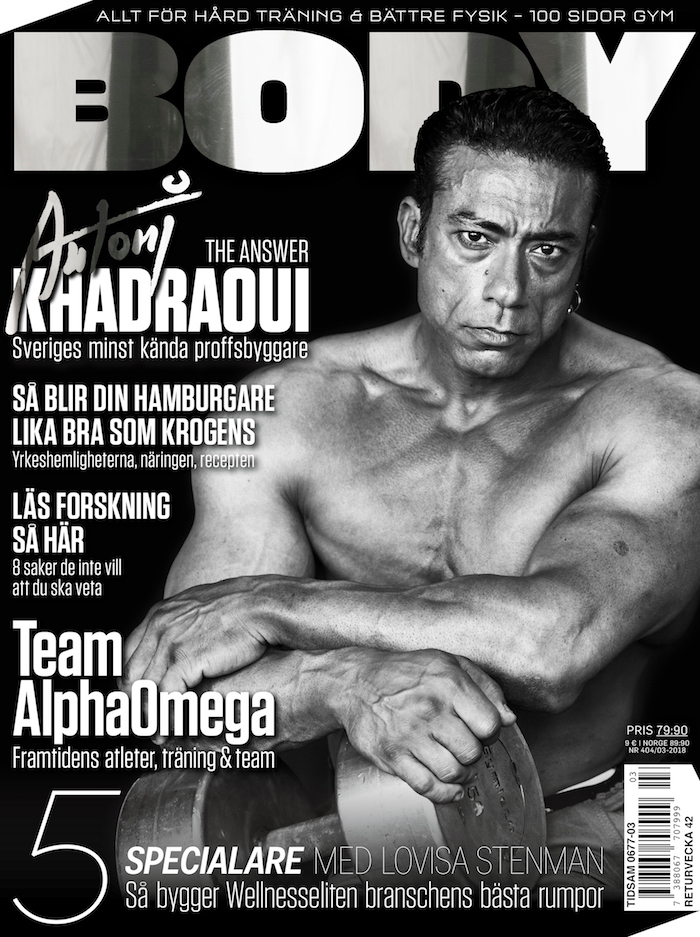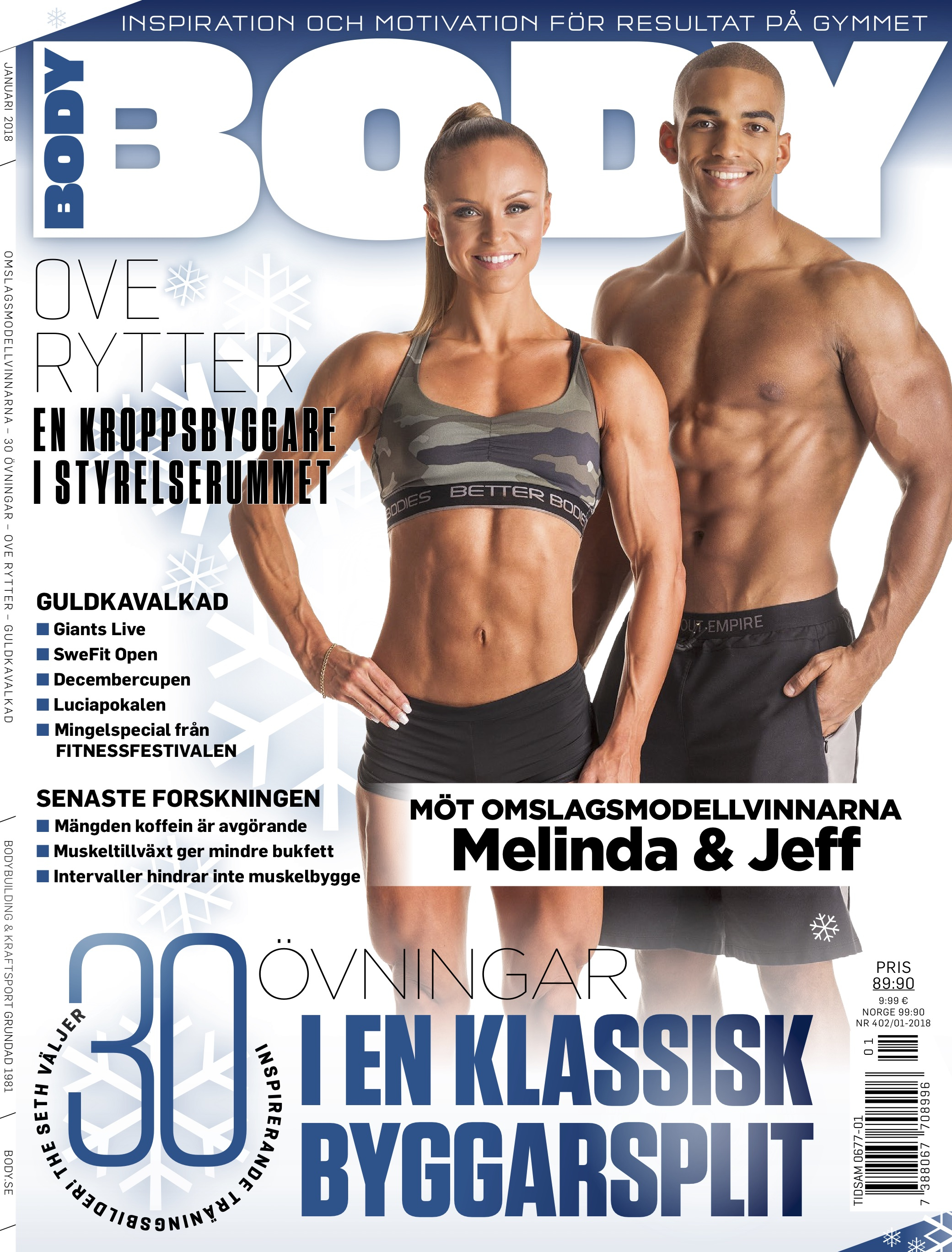Home › Forums › Kosttillskott › Kliniska Studier på tillskott
- This topic is empty.
-
AuthorPosts
-
22 januari, 2008 at 15:15 #376644
Anonym anvandare
MemberPatrikW wrote:Blir inte direkt överskådligt att dumpa en massa studier i en enda tråd för allt som finns på marknaden.Bättre att göra som på optimalbody.com och lägga studier i en speciell kategori.
[http://www.optimalbody.se/forum/forumdisplay.php?f=19]
Hade samma tanke.
22 januari, 2008 at 15:17 #376645Anonym anvandare
MemberHåller med dig!! kanske moderator kan öppna en egen kategori för det här?
Så man här på body kan se överskådligt varje tillskott?PatrikW wrote:Blir inte direkt överskådligt att dumpa en massa studier i en enda tråd för allt som finns på marknaden.Bättre att göra som på optimalbody.com och lägga studier i en speciell kategori.
[http://www.optimalbody.se/forum/forumdisplay.php?f=19]
22 januari, 2008 at 16:02 #376646Anonym anvandare
MemberPatArnold wrote:Denna studie visade att Kre-alkalyn är inte bättre än vanligt kreatin monohydrat.
Dessutom är Kre-alkalyn mer ostabilt i magsyran och omvandlas 35% mer till det verkningslösa biprodukten creatinine.Jämfört med vanlig kreatinmonohydrat som omvandlas bara till 1%.Kre-alkalyn® supplementation has no beneficial effect on creatine-to-creatinine conversion rates
Tallon MJ and Child R.All American Pharmaceutical and Natural Foods Corp. (Billings, MT, USA) claim that Kre-alkalyn® (KA) is a ”Buffered” creatine, is 100% stable in stomach acid and does not convert to creatinine. In contrast, they also claim that creatine monohydrate (CM) is highly pH labile with more than 90% of the creatine converting to the degradation product creatinine in stomach acids. To date, no independent or university laboratory has evaluated the stability of KA in stomach acids, assessed its possible conversion to creatinine, or made direct comparisons of acid stability with CM. This study examined whether KA supplementation reduced the rate of creatine conversion to creatinine, relative to commercially available CM (Creapure®). Creatine products were analyzed by an independent commercial laboratory using testing guidelines recommended by the United States Pharmacopeia (USP). Each product was incubated in 900ml of pH 1 HCL at 37± 1°C and samples where drawn at 5, 30 and 120 minutes and immediately analyzed by HPLC (UV) for creatine and creatinine. In contrast to the claims of All American Pharmaceutical and Natural Foods Corp., the rate of creatinine formation from CM was found to be less than 1% of the initial dose, demonstrating that CM is extremely stable under acidic conditions that replicate those of the stomach. This study also showed that KA supplementation actually resulted in 35% greater conversion of creatine to creatinine than CM. In conclusion the conversion of creatine to creatinine is not a limitation in the delivery of creatine from CM and KA is less stable than CM in the acid conditions of the stomach.
Hoppas att fler får upp ögonen för detta.
23 januari, 2008 at 11:15 #376647Anonym anvandare
MemberDenna studie visade att N-acetyl-cysteine förbättrade muskelprestationen pga av ökad cysteine och glutathione i musklerna.
Och att det minskar ROS(reactive oxygen species) som bidrar till att musklerna tar slut.
Min rekommendation är att man tar max ett gram 30 min innan träning.(2 kapslar)
Tar man mer än det så omvandlas N-acetyl cysteine till nåt som tillverkar fria radikaler och det vill man helst undvika.N-acetylcysteine enhances muscle cysteine and glutathione availability and attenuates fatigue during prolonged exercise in endurance-trained individuals.Medved I, Brown MJ, Bjorksten AR, Murphy KT, Petersen AC, Sostaric S, Gong X, McKenna MJ.
Muscle, Ions and Exercise Group, School of Human Movement, Recreation and Performance (FO22 Victoria University of Technology, PO Box 14428, MCMC, Melbourne, Victoria 8001, Australia.
The production of reactive oxygen species in skeletal muscle is linked with muscle fatigue. This study investigated the effects of the antioxidant compound N-acetylcysteine (NAC) on muscle cysteine, cystine, and glutathione and on time to fatigue during prolonged, submaximal exercise in endurance athletes. Eight men completed a double-blind, crossover study, receiving NAC or placebo before and during cycling for 45 min at 71% peak oxygen consumption (VO2 peak) and then to fatigue at 92% VO2 peak. NAC was intravenously infused at 125 mg.kg(-1).h(-1) for 15 min and then at 25 mg.kg(-1).h(-1) for 20 min before and throughout exercise. Arterialized venous blood was analyzed for NAC, glutathione status, and cysteine concentration. A vastus lateralis biopsy was taken preinfusion, at 45 min of exercise, and at fatigue and was analyzed for NAC, total glutathione (TGSH), reduced glutathione (GSH), cysteine, and cystine. Time to fatigue at 92% VO2 peak was reproducible in preliminary trials (coefficient of variation 5.6 +/- 0.6%) and with NAC was enhanced by 26.3 +/- 9.1% (NAC 6.4 +/- 0.6 min vs. Con 5.3 +/- 0.7 min; P
23 januari, 2008 at 15:40 #376648Anonym anvandare
MemberDenna studie visade att jämfört med placebo så hade inte Arachidonic Acid nån effekt på muskel,styrka och tecken på muskelökning.
Däremot så kan det bidra att man presterar lite bättre på gymmet.
Men då måste man ta 1 gram för att man ska få lite bättre prestation.
I slutändan blir detta dyrt.
Arachidonic Acid är ingrediens i tillskottet X-factor!Effects of arachidonic acid supplementation on training adaptations in resistance-trained males
Michael D Roberts , Mike Iosia , Chad M Kerksick , Lem W Taylor , Bill Campbell , Colin D Wilborn , Travis Harvey , Matthew Cooke , Chris Rasmussen , Mike Greenwood , Ronald Wilson , Jean Jitomir , Darryn Willoughby and Richard B KreiderJournal of the International Society of Sports Nutrition 2007, 4:21doi:10.1186/1550-2783-4-21
Published: 28 November 2007
Abstract (provisional)
Background
To determine the impact of AA supplementation during resistance training on body composition, training adaptations, and markers of muscle hypertrophy in resistance-trained males.Methods
In a randomized and double blind manner, 31 resistance-trained male subjects (22.1 +/- 5.0 yrs, 180.0 +/- 0.1 cm, 86.1 +/- 13.0 kg, 18.1 +/- 6.4% body fat) ingested either a placebo (PLA: 1 g * d-1 corn oil, n = 16) or AA (AA: 1 g * d-1 AA, n = 15) while participating in a standardized 4d * wk-1 resistance training regimen. Fasting blood samples, body composition, bench press one-repetition maximum (1RM), leg press 1RM and Wingate anaerobic capacity sprint tests were completed after 0, 25, and 50 days of supplementation. Percutaneous muscle biopsies were taken from the vastus lateralis on days 0 and 50.Results
Wingate relative peak power was significantly greater after 50 days of supplementation while the inflammatory cytokine IL-6 was significantly lower after 25 days of supplementation in the AA group. PGE2 levels tended to be greater in the AA group. No significant differences were observed between groups in body composition, strength, anabolic and catabolic hormones, or markers of muscle hypertrophy (i.e., total protein content or MHC type I, IIa, and IIx protein content) and other intramuscular markers (i.e., FP and EP3 receptor activity or MHC type I, IIa, and IIx mRNA expression).Conclusions
AA supplementation during resistance-training may enhance anaerobic capacity and lessen the inflammatory response to training. However, AA supplementation does not promote greater gains in strength, muscle mass, or influence markers of muscle hypertrophy.23 januari, 2008 at 15:55 #376649Anonym anvandare
MemberHär är en positiv studie på arakidonsyra.
Effects of arachidonic acid supplementation on training adaptations in resistance-trained males.
Abstract: The purpose of this study was to determine if 50 days of resistance training and arachidonic acid (AA) supplementation elicited changes in body composition, performance variables, hormonal/cytokine levels (i.e. prostaglandins, free and total testosterone, cortisol, and interleukin-6) and/or intramuscular markers [i.e. myosin heavy chain (MHC) I, -IIa, -IIx mRNA and protein levels] in resistance-trained males. Thirty-one subjects (22.1±5.0 yrs, 86.1±13.0 kg, 178.9±3.4 cm, 18.1±6.4 % body fat) were randomly assigned to a placebo (P: n=16; 1 g corn oil/day) or AA group (AA: n=15; 1 g AA/day) and were given supplemental protein in order attain an optimal protein intake of 2 g/kg/day while participating in a 2 d/wk upper body and 2 d/wk lower body resistance training regimen. Body composition, bench press one-repetition maximum (1-RM), leg press 1-RM and Wingate bike sprint tests were completed at 0, 25 and 50 days. Fasting blood was taken on days 0, 25, and 50 and muscle biopsies were taken from the vastus lateralis on days 0 and 50. Body composition, performance variables, hormonal levels and MHC mRNA and protein concentrations were analyzed by ANOVA with repeated measures while independent t-tests were used to assess changes in MHC mRNA expression. A significant increase was observed in Wingate relative peak power in the AA group (p=0.015). Statistical trends were found for PGE2 increases (p=0.06) and IL-6 decrements (p=0.07) in the AA group and a significant decrement in percent changes in MHC IIx mRNA expression was present in the AA group (p=0.015).
Results suggest that AA supplementation in trained males may exert favorable alterations in training adaptations and fasting prostaglandin and IL-6levels. However, additional research is needed to examine this hypothesis.
23 januari, 2008 at 16:23 #376650Anonym anvandare
MemberVart är det positiva?
PatrikW wrote:Här är en positiv studie på arakidonsyra.Effects of arachidonic acid supplementation on training adaptations in resistance-trained males.
Abstract: The purpose of this study was to determine if 50 days of resistance training and arachidonic acid (AA) supplementation elicited changes in body composition, performance variables, hormonal/cytokine levels (i.e. prostaglandins, free and total testosterone, cortisol, and interleukin-6) and/or intramuscular markers [i.e. myosin heavy chain (MHC) I, -IIa, -IIx mRNA and protein levels] in resistance-trained males. Thirty-one subjects (22.1±5.0 yrs, 86.1±13.0 kg, 178.9±3.4 cm, 18.1±6.4 % body fat) were randomly assigned to a placebo (P: n=16; 1 g corn oil/day) or AA group (AA: n=15; 1 g AA/day) and were given supplemental protein in order attain an optimal protein intake of 2 g/kg/day while participating in a 2 d/wk upper body and 2 d/wk lower body resistance training regimen. Body composition, bench press one-repetition maximum (1-RM), leg press 1-RM and Wingate bike sprint tests were completed at 0, 25 and 50 days. Fasting blood was taken on days 0, 25, and 50 and muscle biopsies were taken from the vastus lateralis on days 0 and 50. Body composition, performance variables, hormonal levels and MHC mRNA and protein concentrations were analyzed by ANOVA with repeated measures while independent t-tests were used to assess changes in MHC mRNA expression. A significant increase was observed in Wingate relative peak power in the AA group (p=0.015). Statistical trends were found for PGE2 increases (p=0.06) and IL-6 decrements (p=0.07) in the AA group and a significant decrement in percent changes in MHC IIx mRNA expression was present in the AA group (p=0.015).
Results suggest that AA supplementation in trained males may exert favorable alterations in training adaptations and fasting prostaglandin and IL-6levels. However, additional research is needed to examine this hypothesis.
23 januari, 2008 at 19:52 #376651Anonym anvandare
MemberA significant increase was observed in Wingate relative peak power in the AA group (p=0.015). Statistical trends were found for PGE2 increases (p=0.06) and IL-6 decrements (p=0.07) in the AA group and a significant decrement in percent changes in MHC IIx mRNA expression was present in the AA group (p=0.015).
Results suggest that AA supplementation in trained males may exert favorable alterations in training adaptations and fasting prostaglandin and IL-6levels. However, additional research is needed to examine this hypothesis.
Tolkar inte detta negativt.
23 januari, 2008 at 21:43 #376652Anonym anvandare
MemberDeltagarna fick mer ork när dom gjorde ett cykeltest.
Men ingen fick större styrka eller muskler.PatrikW wrote:A significant increase was observed in Wingate relative peak power in the AA group (p=0.015). Statistical trends were found for PGE2 increases (p=0.06) and IL-6 decrements (p=0.07) in the AA group and a significant decrement in percent changes in MHC IIx mRNA expression was present in the AA group (p=0.015).Results suggest that AA supplementation in trained males may exert favorable alterations in training adaptations and fasting prostaglandin and IL-6levels. However, additional research is needed to examine this hypothesis.
Tolkar inte detta negativt.
24 januari, 2008 at 12:34 #376653Anonym anvandare
MemberPhosphatidylserine har i studier visat att det kan minimera träningvärken,snabba på återhämtningen efter träning och sänka det nedbrytande hormonet cortisol i samband med träning.
Phosphatidylserine har visat minska cortisol nivåer med 30 %
Detta tillskott kan vara bra att använda i perioder då man inleder en tung tränings säsong.
Då Phosphatidylserine förhindrar att man blir övertränad.Denna studie visar att träningvärken minskade med Phosphatidylserine
Fahey TD, Pearl MS: The Hormonal and Perceptive Effects of Phosphatidylserine Administration During Two Weeks of Weight Training-Induced Over-Training.Biol Sport 1998, 15(2):135-144
Denna studie visade att cortisol nivåerna minskade med Phosphatidylserine
Cortisol är ett hormon som bryter ner musklerna och är högst befintliga efter träning.
Monteleone P, Beinat L, Tanzillo C, Maj M, Kemali Effects of Phosphatidylserine on the Neuroendocrine Response to Physical Stress in Humans.
Effects of Phosphatidylserine on the Neuroendocrine Response to Physical Stress in Humans.Denna studie visade att träningvärken minskade
PS supplementation significantly improves muscle soreness [37].Jäger et al. Journal of the International Society of Sports Nutrition 2007 4:5 doi:10.1186/1550-2783-4-5
Dessa studier visade bättre återhämtningsförmåga
Lucia A, Hoyos J, Perez M, Chicharro JL: Heart rate and performance parameters in elite cyclists: a longitudinal study.
Med Sci Sports Exerc 2000, 32(10):1777-1782.
Von Allwörden HN, Horn S, Feldheim W: The Influence of Lecithin on the Performance and the Recovery Process of Endurance Athletes. In Phospholipids: Characterization, Metabolism, and Novel Biological Applications. Edited by: Cevc G, Paltauf F. Champaign: AOCS Press; 1995:319-325.
24 januari, 2008 at 13:24 #376654Anonym anvandare
MemberDenna studie visade att Glycine propionyl-L-carnitine ökade kväveoxid/Nitric oxide i kroppen hos vältränande individer.
Glycine propionyl-L-carnitine finns att köpa hos två tillverkare;Jarrows och Solgar.
Och det kan vara ett bättre alternativ än arginine-AKGGlycine propionyl-L-carnitine increases plasma nitrate/nitrite in resistance trained men
Richard J Bloomer , Webb A Smith and Kelsey H Fisher-Wellman
Department of Health and Sport Sciences, University of Memphis, Memphis, TN, USAJournal of the International Society of Sports Nutrition 2007, 4:22doi:10.1186/1550-2783-4-22
We have recently demonstrated that oral intake of glycine propionyl-L-carnitine (GPLC) increases plasma nitrate/nitrite (NOx), a surrogate measure of nitric oxide production. However, these findings were observed at rest, and in previously sedentary subjects.
Purpose
In the present study, we sought to determine the impact of oral GPLC on plasma NOx at rest and in response to a period of reactive hyperemia in resistance trained men.Methods
Using a double blind, crossover design, 15 healthy men (24 ± 4 years) were assigned to GPLC (3 g/d PLC + 1044 mg glycine) and a placebo in random order, for a four-week period, with a two-week washout between condition assignment. Blood samples were taken from subjects at rest and at 0, 3, and 10 minutes following an ischemia-reperfusion protocol (six minutes of upper arm cuff occlusion at 200 mmHg followed by rapid reperfusion with cuff removal). Blood samples were taken from a forearm vein from the same arm used for the protocol and analyzed for total nitrate/nitrite. Data are presented as mean ± SEM.Results
A condition main effect (p = 0.0008) was noted for NOx, with higher values in subjects when using GPLC (45.6 ± 2.8 μmol·L-1) compared to placebo (34.9 ± 1.2 μmol·L-1). No time main effect was noted (p = 0.7099), although values increased approximately 12% from rest (37.7 ± 2.7 μmol·L-1) to a peak at 10 minutes post protocol (42.3 ± 3.3 μmol·L-1). The interaction effect was not significant (p = 0.8809), although paired time contrasts revealed higher values for GPLC compared to placebo at 3 (48.2 ± 6.7 vs. 34.9 ± 2.4 μmol·L-1; p = 0.033) and 10 (48.8 ± 5.9 vs. 35.7 ± 2.1 μmol·L-1; p = 0.036) minutes post protocol, with non-statistically significant differences noted at rest (41.8 ± 4.5 vs. 33.6 ± 2.5 μmol·L-1; p = 0.189) and at 0 minutes (43.6 ± 5.1 vs. 35.4 ± 2.7 μmol·L-1; p = 0.187) post protocol. An analysis by subject (collapsed across time) indicated that 11 of the 15 subjects experienced an increase in NOx with GPLC treatment.Conclusion
These findings indicate that short-term oral GPLC supplementation can increase NOx in resistance trained men. However, as with many dietary supplements, there exist both ”responders” and ”non-responders” to treatment. Future work may focus on the mechanisms for the discrepancy in response to GPLC supplementation for purposes of NOx elevation.25 januari, 2008 at 10:41 #376655Anonym anvandare
MemberOm nån vill testa Glycine propionyl-L-carnitine så är GPLC ifrån jarrows formula bättre än Solgar.
Det finns ännu inte i Sverige och är endast tillgängligt på Amerikanska sidor.
Dessutom måste man ta 4 gram i samband med en kolhydratrik måltid för bästa effekt.
4 gram kommer bli dyrt men det kommer nog komma andra tillverkare.
Förhoppningsvis hoppas jag på bra tillverkare och det kommer nog få ner priset på Glycine propionyl-L-carnitine
Just nu är detta väldigt dyrt!25 januari, 2008 at 11:39 #376656Anonym anvandare
MemberLåt oss börja med Vanadyl sulfat som kom som tillskott på 90 talet.
Än idag säljs den och varför förstår jag inte.
Vanadyl sulfat hjälper att transportera in näring och glukos ifrån blodomloppet in till musklerna och fettcellerna.
En dos av vanadyl sulfat kan hålla i sig rätt länge och därav har experter inom området diabetes rekommenderat att Vanadyl Sulfat ska användas i tre veckor och sen pausas i tre veckor.
Vanadyl sulfatet fortsätter att verka i ytterligare tre veckor efter att man har slutat att använda det.
Vanadyl Sulfat användes inom diabetes området för att det härmar insulin och gjorde så att diabetes patienter kunde ta mindre insulin.
Det tryck eller pump ni känner är pga av dess höga potentiella förmåga att transportera socker(kolhydrater) in i musklerna.
Men i studien:
Fawcett J, et al.: The effect of oral vanadyl sulfate on body composition and performance in weight-training athletes.
International Journal of Sport Nutrition 1996, 6:382-90
Visade att vanadyl sulfat gav ingen förändring på muskler,fett men en aning styrka ökades men inte märkvärdigt.
[http://www.ncbi.nlm.nih.gov/pubmed/8953340?dopt=Abstract]Dessvärre är vanadyl sulfat inget jag rekommenderar,det har visat sig vara giftigt och cancerframkallande.
Läs denna studie;
Vanadyl sulfate can differentially damage DNA in human lymphocytes and HeLa cells
Authors: Wozniak, Katarzyna1; Blasiak, Janusz2Source: Archives of Toxicology, Volume 78, Number 1, January 2004 , pp. 7-
Det bättre valet är R-ALA ifrån AST25 januari, 2008 at 12:06 #376657Anonym anvandare
MemberJag läste en studie för ungefär några år sen och blev sen förvånad över att det kom en massa CEE produkter.
Alla tillverkarna pratade om ett snabbt verkande kreatin som hette Creatin ethyl ester.
På vissa Åf Butiker så var det som att komma till ett hallelujamöte med kristibrud när dom pratade om det*skrattar*
I denna studie så lyckades forskarna skapa CEE redan 1954.
Men tyvärr visade det sig att CEE var väldigt ostabilt och att den omvandlades snabbt till kreatinin.
Dom såg att CEE hade en hög upptagningsförmåga precis som tillverkarna sa.
Men i takt med den höga upptagningsförmågan omvandlades CEE snabbt till verkningslöst kreatinin.
Som alla vet så är kreatinin en hög belastning för njurarna och kan skada dom.
Denna studie visade att vid tillverkning av CEE så bildades det redan Kreatinin.
Tänk er då vid konsumtion om vad som händer då?
Faktum är att jag tror inte att det säljs nåt riktigt CEE men tillverkarna påstår det.
Och det är nog för att dra nytta av vad som stog i studien om upptagningsförmågan.
Min misstanke är att det är vanligt kreatin monohydrat mixat med nåt så folk inte ska misstänka.[http://pubs.acs.org/cgi-bin/abstract.cgi/jacsat/1955/77/i01/f-pdf/f_ja01606a060.pdf]
Mvh
PatArnold25 januari, 2008 at 23:42 #376658Anonym anvandare
MemberPatArnold wrote:Jag läste en studie för ungefär några år sen och blev sen förvånad över att det kom en massa CEE produkter.
Alla tillverkarna pratade om ett snabbt verkande kreatin som hette Creatin ethyl ester.
På vissa Åf Butiker så var det som att komma till ett hallelujamöte med kristibrud när dom pratade om det*skrattar*
I denna studie så lyckades forskarna skapa CEE redan 1954.
Men tyvärr visade det sig att CEE var väldigt ostabilt och att den omvandlades snabbt till kreatinin.
Dom såg att CEE hade en hög upptagningsförmåga precis som tillverkarna sa.
Men i takt med den höga upptagningsförmågan omvandlades CEE snabbt till verkningslöst kreatinin.
Som alla vet så är kreatinin en hög belastning för njurarna och kan skada dom.
Denna studie visade att vid tillverkning av CEE så bildades det redan Kreatinin.
Tänk er då vid konsumtion om vad som händer då?
Faktum är att jag tror inte att det säljs nåt riktigt CEE men tillverkarna påstår det.
Och det är nog för att dra nytta av vad som stog i studien om upptagningsförmågan.
Min misstanke är att det är vanligt kreatin monohydrat mixat med nåt så folk inte ska misstänka.[http://pubs.acs.org/cgi-bin/abstract.cgi/jacsat/1955/77/i01/f-pdf/f_ja01606a060.pdf]
Mvh
PatArnoldDet kan nog ha hänt en del i utvecklingen sedan 1954. Tex vilken form av kreatin som användes. Numera utgår man vanligen från Cr-monohydrat, blandar det med etanol och väteklorid i ett specifikt förhållande. Kan tänka mig att det är en flera parametrar som kan påverka bildningen av kreatinin.
-
AuthorPosts
- You must be logged in to reply to this topic.






